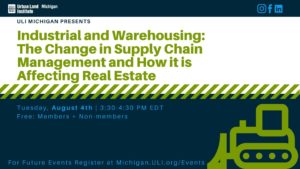Here to Help Series: The Change in Supply Chain Management

By Victoria Comer and Corissa Green
Webinar Part 6 Recap
ULI Michigan Here to Help Webinar Series
The Change in Supply Management and How it is Affecting Real Estate
On Tuesday, August 4th, we hosted Part 6 of the ULI Michigan Here to Help webinar series. Our expert panelists in Brownfield and Industrial real estate discussed the growing demand and change in infrastructure for industrial and warehousing sites. Joined by: Elie Torgow, Chief Executive Officer of the SterlingGroup; Kevin Hegg, Vice President at Ashley Capital; Dan Cassidy, CPG, Vice President and Principal of SME; and Drew Coleman, Director of US & Foreign Direct Investment, MEDC. They explored Last Mile facilities, risk mitigation, and economic attraction for large, multi-level industrial facilities.
Click Here for the Full Slidedeck
Dan Cassidy – Vice President and Principal, SME (Co-Chair ULI Michigan) Moderated the conversation, focusing on brownfield development, obstacles in redevelopment, and where the future opportunities are.
Kevin Hegg – Vice President, Ashley Capital showcased current SE Michigan projects, including an Amazon development, Last Mile facilities, and what he looks for in a potential site.
Elie Torgow – Chief Executive Officer, SterlingGroup discussed the company’s history and the pivotal moment they went from residential to industrial real estate, the increased demand for site ready warehousing versus land ready, and the positive outlook for the industry.
Drew Coleman – Director of US & Foreign Direct Investment, Michigan Economic Development Corporation explored the importance of transparent communication, what the State is doing to maintain positive relationships with producers in the supply chain in a COVID/post-COVID world, and how to plan for risk mitigation.
Key Takeaways: (*Our takeaways should only be viewed as content we were able to extract from the conversation and not direct quotes from our panelists)
- Increasing need for warehouse space because of companies such as Amazon
- Location is important for warehouse sites- access to highways and major roadways
- “Just in Time”/Last mile delivery warehousing is needed so that products can get to consumers faster
- Products need to be close to the source
- Automotive manufacturing in Detroit also fuels the need for large warehouse space in Metro Detroit – proximity to automotive factories is essential
- Huge change in buying patterns because of COVID-19 and stay at home orders
- Supply chains are changing to adapt to new circumstances
- Changes in business models to adapt
- Companies are looking to allocate assets and activate markets
- Opportunistic activity taking place, but companies are trying to mitigate risks
- Post-COVID customers won’t necessarily go back to old buying patterns
- The customer will continue to order products to their door instead of going to the store
- Some companies are requesting rights to bigger buildings or more acreage to build because they aren’t sure exactly what is going to happen over the next 12-24 months, but they are optimistic that business will continue to grow
- New requirements for warehouses and continued change in the market
- Multistory coming back after decades of single-story warehouse needs
- Challenges faced in Detroit market
- Brownfield sites are popular for industrial development because of Detroit’s past industry and can pose some risks
- Developers must work with engineer teams on these sites and eliminate any issues
- Power requirements have sky-rocketed
- Grid sometimes cannot support the requirements for some of these industrial uses
- Brownfield sites are popular for industrial development because of Detroit’s past industry and can pose some risks
- Supply chains are changing to adapt to new circumstances
For more information about the importance of Industrial Real Estate in a post-COVID world, please check out this article from The Wall Street Journal.
